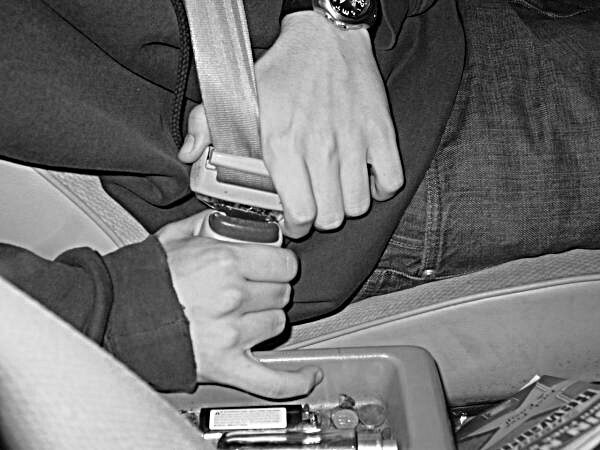
United States – Seat belt use by type of law in the US, 2008 In the United States, seat belt legislation varies by state. The state of Wisconsin introduced legislation in 1961 requiring seat belts to be fitted to the front outboard seat positions of cars. Seat belts have been mandatory equipment since the 1968 model year per Federal Motor Vehicle Safety Standard 208,
New York State passed the first law in the US mandating the use of seat belts in 1984 under the leadership of John D. States, an orthopedic surgeon who dedicated his career to improving automotive safety. Depending on which state a driver is in, not wearing a seat belt in the front seat is either a primary offense or a secondary offense, with the exception of New Hampshire, which does not have a law requiring people over age 18 to wear a seat belt.
In the front seat, the driver and each passenger must wear a seat belt, one person per belt. In some states, such as New York, New Hampshire, and Michigan, belts in the rear seats are not mandatory for people over the age of 16. The driver and front-seat passengers aged 16 or older can be fined up to $50 each for failure to wear a seat belt. Seat belt use by sex, age, and type of law in the US, 2008 A primary offense means that a police officer can pull a driver over for the seat belt law violation alone, and secondary offense indicates that one can be punished for a seat belt law violation only if they are already pulled over for another reason.
When did seat belts become law in UK?
A selection of historic THINK! adverts have been made available online to celebrate 30 years of the seatbelt law. Three decades of compulsory seatbelt use are being marked today as the government made a selection of historic THINK! adverts available online. The law requiring all drivers to wear their seatbelts came in to force 30 years ago today (31 January 2013) – on 31 January 1983.
Car manufacturers have had to install seatbelts since 1965 but the law requiring drivers to wear them did not come in to force for another 18 years. In 1991 the law changed again making it a legal requirement for adults to wear seatbelts in the back of cars. Road Safety Minister Stephen Hammond said: Thousands of lives have been saved and countless injuries prevented over the years because drivers and passengers were wearing seatbelts.
The combination of effective enforcement and hard-hitting public awareness campaigns mean that, 30 years on, the vast majority of drivers and passengers buckle up when they get in their cars. But, unbelievably, there are still some people who do not use a seatbelt – my message to them is simple: a seatbelt could save your life and not wearing one is just not worth the risk.
When did it become mandatory to wear a seatbelt in the US?
Dole issued a rule in 1985 that required automakers to install driver’s side airbags in all new cars unless—and this is the kicker—two-thirds of the states passed mandatory seat belt laws by April 1, 1989.
Did cars have seat belts in 1970?
September 14, 2016 by Defensive Driving | in Defensive Driving Online, Driving and Safety Tips, news  The seat belt is one of our best protections in a car crash. In fact, according to the Center’s for Disease Control and Prevention, “seat belt use is the most effective way to save lives and reduce injuries in crashes as more than half (range from 53% – 59%) of teens and aged 13 – 44 years who died in crashes in 2014 were unrestrained at the time of the crash.” In short, seat belts save lives, but how did then end up in our cars in the first place? Below is a brief history of the car seat belt.
The seat belt is one of our best protections in a car crash. In fact, according to the Center’s for Disease Control and Prevention, “seat belt use is the most effective way to save lives and reduce injuries in crashes as more than half (range from 53% – 59%) of teens and aged 13 – 44 years who died in crashes in 2014 were unrestrained at the time of the crash.” In short, seat belts save lives, but how did then end up in our cars in the first place? Below is a brief history of the car seat belt.
- The seat belt was invented by George Cayley, an English engineer in the late 1800’s who created these belts to help keep pilots inside their gliders.
- However, the first patented seat belt was created by American Edward J.
- Claghorn on February 10, 1885 in order to keep tourists safe in taxis in New York City.
Over time, the seat belt slowly starting showing up in manufacture cars to help passengers and drivers stay put inside their car seats. There was less concern for overall driving safety. Though invented in the late 1800’s, it wasn’t until the mid 1930’s when several U.S.
physicians began testing lap belts and immediately saw their impact and began urging manufacturers to provide seat belts in all cars. In 1954, Sports Car Club of America required competing drivers to wear lap belts during competitions and in the following year, the Society of Automotive Engineers (SAE) appointed a Motor Vehicle Seat Belt Committee.
Race car drivers were the first to really wear seat belts to help protect them against serious internal injuries. The real breakthrough with modern seat belts came in 1958 when Swedish engineer Nils Bohlin invented the three-point seatbelt. Up until this point, seat belts in cars were two-point lap belts, which strapped across the body, with the buckle placed over the abdomen.
Volvo hired Bohlin in 1958 and he designed the seat belts we know today through a three point seat belt that better protects the driver and passenger in an accident. The three point design was created to help secure both the upper and lower body. Better yet, this seat belt design was simple and effective, leading other car manufacturers to borrow the design.
When Bohlin passed away in 2002, Volvo had estimated that the seat belt had saved more than one million lives in the four decades since it was introduced. Once the idea of safety benefits of seat belts caught on in the U.S. public, sales of seat belts skyrocketed.
Do you have to wear a seat belt in old cars?
We all know the drill. The first thing you do when you slide behind the wheel is buckle up for safety. If you don’t, you risk getting a ticket that could cost you as much as $271. So what’s up with all these vintage car owners who cruise around Southern California sans seat belts? How safe is that? Not a day goes by that I don’t see someone zipping around in a vintage automobile-a ‘50s-era Cadillac or a dilapidated Volkswagen Beetle from the ‘60s.
- Recently I pulled up next to a slick ’55 Chevy carrying a group of teenagers.
- No one appeared to be wearing a seat belt-certainly a cause for alarm.
- But because the car was manufactured before the 1964 federal law requiring factory-installed seat belts, no safety restraints are required.
- Under the law, owners of classic cars are not required to install safety belts or shoulder harnesses if they were not original equipment on the vehicles, said Kim Hazelbaker, senior vice president of the Insurance Institute for Highway Safety in Arlington, Va.
Safety-conscious owners, such as Bob Ford, 60, of Villa Park, who also drives a ’55 Chevy, have voluntarily added the safety equipment. But chances are the owner of that other Chevy, with its carload of teenagers, did not. Stephanie Tombrello, executive director of SafetyBeltSafe USA, said driving without seat belts, especially in a vintage car, is putting your life on the line.
- Anyone riding around in a classic car without belts is at major risk if they get into an accident.
- The older the car, the less forgiving it will be in an accident,” said Tombrello, whose nonprofit national group, based in Torrance, advocates strong seat-belt and child car-seat safety laws.
- Even car buffs are split about whether safety should prevail over retaining their vehicles’ original state.
The use of seat belts is a civil liberties issue, one colored by the fact that some early retrofitted seat belts “weren’t the safest,” said McKeel Hagerty of Hagerty Classic Insurance, an agency that insures vintage vehicles. “If you owned a car from the ‘30s and wanted to win a car show, you wouldn’t put seat belts in it, because you could lose points from the judges,” Hagerty said.
- But today, he said, there is a new generation of collectors who are more concerned about the safety of their passengers than winning shows.
- Still, said Ford, who writes a newsletter for owners and fans of 1955-57 Chevys, he knows of car buffs who neglect to install belts to secure their children.
- Some simply believe that any modification to a classic car is bad, he said.
Seat-belt laws vary among states. But in California, the law that exempts classic cars from having seat belts applies to adults, not children. State traffic safety regulations dictate that children younger than 6 or who weigh less than 60 pounds must be secured in a booster seat or child safety seat even if they are in a vintage vehicle, said Anne DaVigo, a spokeswoman with the California Highway Patrol in Sacramento.
Why does New Hampshire not have seatbelts?
So the roads are less hazardous in New Hampshire than they are in many other states.’ I explained to Russ that we have, as a state, collectively considered passing seat belt laws in the past and decided we preferred that the government just stay out of it.
What car had the first seat belts?
The first three-point seatbelt was sold in a Volvo PV544 in Sweden on August 13, 1959. It took several years after that for the feature to catch on with automakers and the public, and the first U.S. federal law mandating seatbelts wasn’t till 1968. Volvo patented its belt design but allowed anyone to use it, and the company still allows open-source access to its crash-research data today.
What do you wear every time you get in the car that’s thin, smooth, and is believed to have saved over a million lives since 1959? That’d be the three-point seatbelt, and you have Volvo to thank for its presence in your car. On August 13, 2019, it turned 60, and it’s still going strong, even if you might take it for granted.
What was the first year seat belts were in cars?
However, the first car model to have the three-point seat belt as a standard item was the 1959 Volvo 122, first outfitted with a two-point belt at initial delivery in 1958, replaced with the three-point seat belt the following year.
